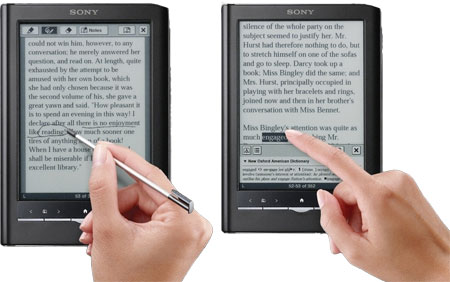Sony Reader PRS-350, PRS-650 and PRS-950 - new ebooks from Sony

On September 1, Sony pleased its fans by updating the line of e-books running on E-Ink technology. As expected, the new books use the E-Ink Pearl screen, first installed on the latest generation of e-books from Amazon: Kindle DX Graphite and Kindle 3. Sony has not always pleased us with the quality of performance of their e-books, this note is true for touch-screen models . But Sony would not be Sony, if it had not finally corrected its mistakes, due to which the display with a touch layer noticeably lost its contrast and was highly reflective. The updates use a new patented technology from Neonode: Optical touch screen.
As a result, we get:
')
- 100% transparency, as there is no additional layer that glare and degrades the screen contrast
- Finger control, no special stylus required
- New E-Ink Pearl with 10: 1 contrast
- Excellent quality and design from Sony
A little worth mentioning is technology from Neonode. An infrared frame around the display is used. The controller emits a series of pulses to create a grid of infrared rays on the display. When you touch the screen, the passage of a part of the rays is hampered, thereby allowing to calculate the coordinates that give an idea of the place of touch. Interpolation in combination with analog signal processing, make it possible to use multitouch with a high processing speed in this technology.
Whether to use multitouch in the new books from Sony, is not yet known. Rather not, than yes, because its use on such devices is very limited. But even without this, the books turned out very "tasty." Now that the touch screen is not a hindrance to reading, it will be possible to appreciate all its advantages.
The touch display provided all the new items, even the younger PRS-350 Pocket Edition. A total of 3 new models will be on sale: PRS-350 Pocket Edition, PRS-650 Touch Edition and PRS-950 Daily Edition (updated PRS-300, PRS-600 and PRS-900 respectively). Dimensions remain the same: PRS-350 - 5 ", PRS-650 - 6" and PRS-950 - 7. "It's a pity, I really want to see in the Sony version of the book on 9.7".
PRS-650 Touch Edition can be seen in the picture under the title of this article.
PRS-350 Pocket Edition

PRS-950 Daily Edition

Only Sony Reader PRS-350 and PRS-650 will be available for sale in the next few days, pre-order is already available. According to some reports, the PRS-950 will go on sale only by the end of this year. Well, we'll see. For some, it will be unpleasant news that Wi-Fi and free 3G (for access to the Reader ™ Store) will be installed only on the Daily Edition, thus depriving the younger models.
All new models will be equipped with 2 GB of internal memory + slots for SD and MS memory cards in the PRS-650 and PRS-950. Charging will now be done through the Micro-USB connector. Not including a simple case, not to mention a cover, was not a very good trend for many manufacturers. Well, this is a price reduction. In terms of format support, nothing has changed, but there is also good news, the text in the ePub format is finally right aligned on all new models. According to the manufacturer, on one charge the book will work 2 weeks (about 7,500 turning over). The battery capacity is slightly increased, but this did not affect the operation time, it seems that such a step was taken so that the operation time did not decrease due to the new Optical touch screen. I can not miss an interesting innovation, now you can adjust the contrast and brightness (?) Display. “Why?” - you ask. I do not know.
And finally, about the price. Pocket Edition - $ 179 , Touch Edition - $ 229 and Daily Edition - $ 299
New books will surely find their buyer, so for me, Sony has beautifully emerged from the price war. Yes, they do not sell books below cost, as the content makes significantly less money than the same Amazon. But putting forward additional features in the form of a new touchscreen and software, sharpened by it, while slightly inferior in price to the new Amazon Kindle and Barnes & Noble Nook, they will undoubtedly interest many. I am glad that Sony decided to stay in the e-book market, not being afraid to compete with such book-selling giants as Amazon and Barnes & Noble.
After all, the more choice - the better for the end user.
Source: https://habr.com/ru/post/103318/
All Articles